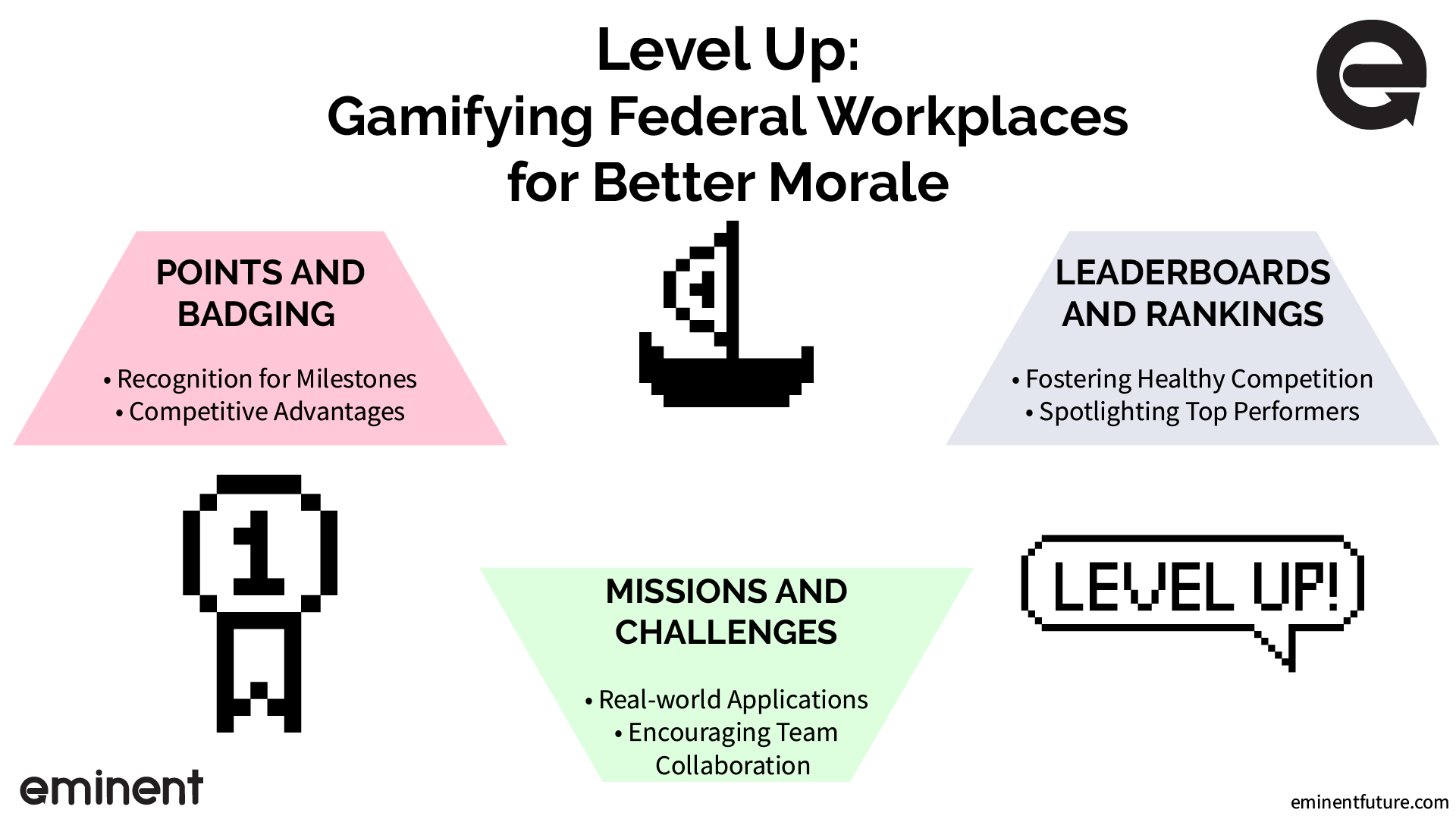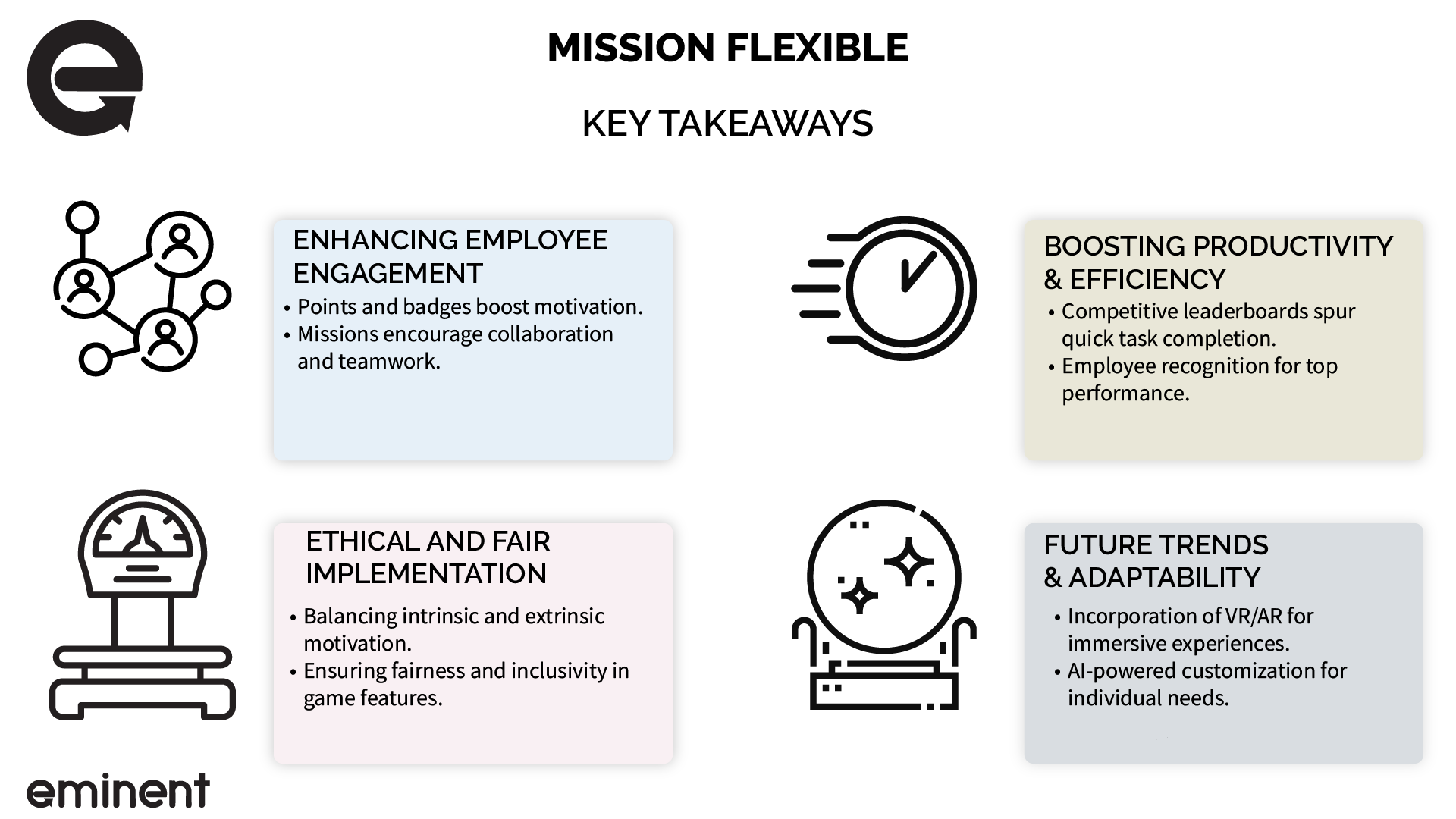Gamification, using game-like elements such as points and leaderboards, has successfully elevated engagement and productivity in corporations, healthcare, and education. Yet, federal agencies must work on low employee engagement due to bureaucratic inefficiencies and limited upward mobility. Could the gamification strategies that transformed other sectors also revitalize the federal workforce?

This article explores the feasibility and potential impact of applying gamification to federal roles. We will delve into specific strategies and how they can be implemented nationally and discuss the challenges and ethical considerations involved.
The goal is to assess whether gamification could be the key to unlocking greater productivity and engagement among federal employees.
Why Gamification Matters for Federal Agencies

Employee Engagement Crisis
Current State of Federal Employee Morale
While some federal agencies boast high levels of employee satisfaction, the overall picture could be more precise. Bureaucratic red tape, lack of advancement opportunities, and the public scrutiny that often comes with government jobs can all contribute to lowered morale among federal workers.
The Cost of Low Engagement
The repercussions of low engagement are far-reaching and can harm the federal agency’s effectiveness and efficiency. Disengaged employees are less likely to take initiative, be productive, or contribute to an organization’s mission. This lack of engagement can increase costs regarding lost productivity and higher turnover.
Benefits of an Engaged Workforce
Increased Productivity
Engaged employees are not just more content; they’re more productive. They’re likelier to put in the extra effort that can make the difference between meeting and exceeding performance objectives. In the context of federal agencies, this heightened productivity can translate to faster and more efficient delivery of public services.
Improved Employee Retention
Engagement doesn’t only affect productivity; it also correlates with retention rates. Employees who feel engaged are far less likely to leave their jobs. High retention rates offer a significant long-term benefit given the cost and effort involved in hiring and training new federal employees.
Overview of Gamification Benefits
Higher Engagement Levels
Gamification taps into human psychology by providing rewards, recognition, and a sense of accomplishment, which can significantly boost engagement. Whether it’s earning points for completing tasks or badges for reaching milestones, gamification adds an element of fun and competition that can liven up a federal workplace.
Enhanced Skill Development
Gamification isn’t just about making work fun; it can also be a powerful tool for skill development. Through gamified training programs or problem-solving challenges, federal employees can hone their skills in a way that feels engaging and rewarding rather than tedious or obligatory.
Add Your Heading Text Here
Types of Gamification Strategies for Federal Roles

Points and Badging Systems
Recognition for Milestones
Implementing a point and badging system is a motivational tool for federal employees. Workers can earn badges that recognize their accomplishments as they achieve specific tasks or milestones. These badges can be displayed on internal communication platforms, increasing visibility and acknowledgment within the team.
Competitive Advantages
Badges and points can also foster a healthy sense of competition among colleagues. Employees can compare badges and perhaps even convert points into tangible rewards, creating a cycle of continuous improvement and competitive advantage within the federal agency.
Missions and Challenges
Real-world Applications
Missions and challenges can be built around real-world applications pertinent to the federal role. For instance, an agency focused on public health might introduce a series of challenges around epidemic response planning. These missions can be timed, requiring employees to collaborate to find the best solutions within a given period.
Encouraging Team Collaboration
Through shared missions and challenges, employees have the opportunity to collaborate intensively. This not only enhances teamwork but also allows the team’s collective intelligence to solve complex problems, further aligning with the objectives of the federal agency.
Leaderboards and Rankings
Fostering Healthy Competition
Leaderboards can take the competitive aspects of points and badging systems to the next level. Displaying a real-time leaderboard on internal platforms can boost the competitive spirit among employees. This is especially effective for roles requiring rapid task completion or problem-solving.
Spotlighting Top Performers
Leaderboards are also excellent tools for recognizing and spotlighting top performers in real-time. This kind of recognition can motivate employees to continually engage in their work, thereby increasing overall productivity and efficiency in achieving federal objectives.
By implementing these gamification strategies customized for federal roles, agencies can stimulate employee engagement and performance, create an interactive and competitive work environment, and better align with organizational objectives.
Add Your Heading Text Here
Implementing Gamification in Federal Agencies

Identifying Objectives and Metrics
Objectives and KPIs
Before rolling out any gamification features, agencies must first identify their specific objectives and key performance indicators (KPIs). Whether focusing on increasing productivity, boosting employee morale, or enhancing skill development, having a clear goal is vital for successfully implementing gamification strategies.
Metrics for Success
Equally important is the selection of metrics that will be used to measure the success of these gamification efforts. These could include employee engagement scores, completion rates for missions and challenges, or the number of badges earned across the organization.
Customizing Gamification to Federal Roles
Role-Specific Games
Generic gamification features may only resonate with some employees, especially in a diverse workplace like a federal agency. Therefore, customizing the gamification elements to be relevant to the specific roles and departments within the agency is crucial for maximizing engagement.
User Experience
The design and user experience of the gamification features should be tailored to be as intuitive and engaging as possible, ensuring it doesn’t disrupt the employees’ workflow.
Stakeholder and Employee Buy-in
Executive Sponsorship
Executive sponsorship is essential for any initiative to succeed within a bureaucratic structure. Ensuring the agency’s leadership is on board can pave the way for a smoother implementation process.
Team member Feedback Loops
Open channels for employee feedback before, during, and after the gamification features are rolled out can provide invaluable insights into what’s working and what needs improvement.
Pilot Testing and Scaling
Proof of Concept
Implementing a small-scale pilot among a select group of employees can serve as a proof of concept, helping to identify any issues or areas for improvement before a full-scale roll-out.
Scaling Strategies
Once the pilot has proven successful and adjustments have been made, the agency can develop a strategy for scaling the gamification features to include more departments or the entire organization.
Ongoing Monitoring and Adjustments
Performance Review
Constant monitoring of the identified metrics will indicate the ongoing success or areas for improvement in the gamification strategies.
Iterative Improvements
Agencies should be prepared for regular adjustments to the gamification features based on both quantitative metrics and qualitative feedback, ensuring the initiative stays aligned with its objectives.
Implementing gamification in federal agencies is a
multi-step process that requires careful planning, customization, and ongoing
adjustments. With the right strategies in place, agencies stand to reap
significant benefits in terms of employee engagement and productivity.
Add Your Heading Text Here
Challenges and Ethical Considerations

Risk of Reducing Intrinsic Motivation
Striking a Balance
While gamification can be an effective motivator, there is a risk that it could overshadow intrinsic motivation, leading employees to focus more on rewards than on the work itself. Striking a balance between intrinsic and extrinsic motivators is crucial to ensuring the long-term success of gamification initiatives.
Employee Feedback Mechanisms
Regularly soliciting feedback from employees can help agencies fine-tune their gamification efforts. Feedback loops can reveal if the strategies in place are affecting intrinsic motivation and provide insights for adjustments.
Fairness and Equity
Avoiding Discrimination
There’s a potential risk that gamification could inadvertently discriminate against some employees. For example, a leaderboard may not be suitable in an environment where some roles naturally offer more opportunities to earn points. Agencies must consider these factors to ensure that the gamification features are designed to be as equitable as possible.
Inclusivity in Gamification
Inclusivity should be a priority in any gamification strategy. This could involve designing features accessible to employees with disabilities or ensuring that opportunities for earning points and badges are equally distributed among various roles and departments.
Challenges and ethical considerations must be thoughtfully addressed to ensure that gamification is a force for good within federal agencies. Agencies can implement more effective and fair gamification strategies by understanding and mitigating these risks.
Add Your Heading Text Here
Future of Gamification in Federal Agencies

Upcoming Trends in Workplace Gamification
Virtual Reality (VR) and Augmented Reality (AR):
These technologies are expected to play an increasingly significant role in gamification strategies, providing more immersive experiences.
AI-Powered Personalization:
Artificial intelligence can tailor gamification elements to individual preferences and performance, enhancing engagement.
Adapting to Changes in Federal Work
Remote Work Adaptability:
As remote work becomes more prevalent, gamification strategies must be flexible enough to engage employees in a decentralized work environment.
Compliance with New Policies:
Any gamification strategy should be agile enough to adapt to new federal policies or guidelines, such as data privacy regulations.
Sustainability:
Federal agencies should look for sustainable gamification strategies in the long run, both environmentally and in terms of employee engagement.
Long-term Engagement and Employee Development
Continuous Learning:
Gamification can be a tool for ongoing education and skill development, not just a one-time engagement boost.
Feedback Loops:
Regular feedback mechanisms can ensure that gamification remains practical and relevant to the changing needs of the workforce.
Employee Wellness:
Future trends may involve gamifying aspects related to employee well-being, such as stress management and mental health resources.
By staying abreast of these trends and adaptabilities, federal agencies can implement gamification more effectively today and sustain its benefits into the future.
Add Your Heading Text Here
Navigating the Gameboard: A Final Take on Gamification in Federal Workplaces

The transformative potential of gamification in federal agencies is evident. From enhancing employee engagement to streamlining processes, game elements offer a robust toolkit for modernizing the national work environment. Various departments, such as the IRS, DOE, and VA, have already set successful precedents.
However, it’s essential to approach gamification with a balanced view, considering ethical implications and potential drawbacks. This includes the risk of diminishing intrinsic motivation and the need for fairness to ensure inclusivity. Customization to specific federal roles and ongoing adjustments based on data are critical for success.
Emerging trends in workplace gamification offer exciting prospects for future applications within federal agencies. As work norms and technologies evolve, so will the strategies for effectively gamifying the federal workspace.
In conclusion, gamification isn’t a fleeting trend but a sustainable strategy that can revamp how federal agencies operate, ultimately benefiting employees and the public they serve.



